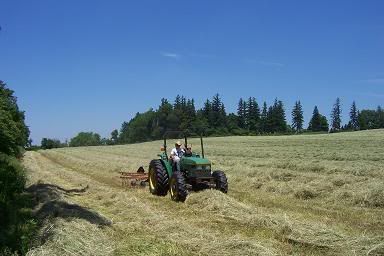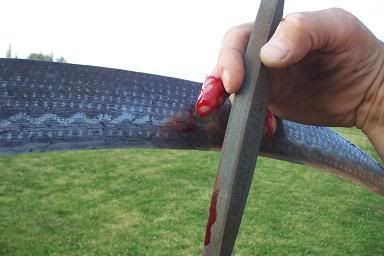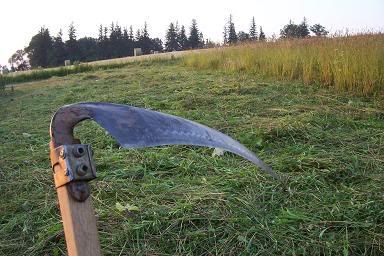Dateline: 26 June 2007
PLEASE NOTE: Before reading this story I feel I should warn you that it contains a graphic picture of a bloody accident (but don’t let that stop you)….
In my book, Writings of a Deliberate Agrarian, I have a chapter titled, Hay Help. It is one of my favorite stories in the book because it evokes memories of the “hay days” of my youth.
It is because I loved working in the hay that I’m so pleased to see two of my sons, Robert & James, also active as hay helpers. They are on call for three local farmers. In between that, they occasionally help a farmer’s market grower with her field work. In other words, they are busy doing the hard outdoor work of a farmer, even though we do not have a farm. I think it is toil of the most beneficial kind, especially for a youngster.
Yesterday, while James was helping load hay bales in the barn for one farmer, Robert was on a tractor raking hay for another. He happened to be in the field across from our house. So Marlene went out and snapped a couple pictures of her farm boy…


Later in the day, as the sun was setting and the air temperature cooled, I got a hankering to mow some hay. I don’t have a field of my own but my next door neighbor (who lives up the road aways) does. The field has grown tall, not with hay so much as weeds. But beggars can’t be choosers. I’m thankful to have use of the land.
This field is where I intend to pasture my turkeys as they get bigger. So it needed to be cut. At least a section of it did. With that in mind, I have been seriously considering the purchase of a sickle bar attachment for my BCS walk-behind tractor. I think it would be so cool to mow through the tall grass with such a tool. But I have decided to wait. I’m hesitant to spend the money just to create pasture for 12 turkeys.
So, instead, I took my scythe and sharpening stone in hand and headed to the field. It so happens that using my scythe to mow down tall grass is something I sincerely love to do. I think my appreciation and fascination for this once common, but now almost forgotten, rural skill goes back to when I was a little boy and I once watched my grandfather scythe the tall grass on a steep bank by his house. This primitive skill appealed to something deep within me then and it still does now, more than ever.
It gives me such satisfaction to swing a scythe through tall grass, laying it low, again and again, as I walk head, along the edge of the field. Properly done, the process is less work and more technique. Of course, a good scythe with a sharp edge makes all the difference. And so does practice; the more you mow, the better you get.
My objective when hand-mowing is to establish a rhythm, a cadence of measured steps and overlapping, sweeping, parabolic arcs of the scythe blade. Each cutting motion begins with my upper torso comfortably twisted to the right, the calf-high scythe extended and ready to do its work. My turned body is like a wound spring. As I unwind the spring, turning to the left, I bring the blade down, level with the ground, and through the swath. The sharpness of the blade and the momentum of the movement does the hardest work.
I follow through with the cut. The scythe, like a pendulum in my arms, twists my upper torso to the left. The spring winds again. When a comfortable apex of movement is reached, the spring unwinds back to the right, back to the cutting position. I take a step forward. The cycle repeats. Progress is slow, but sure.
When you mow tall grass with a scythe, you focus not only on the motion but on the plant life before you. You must “read” each swath before you mow it. You do not stop to “read.” It is done as you are moving ahead. If the foliage is especially dense, you may take less of a swath. If you encounter a thick-stemmed weed, you must put a bit more into the swing. And you can not help but see and consider all the different grasses and sedges and weeds that come before you. It is a natural experience that fills your senses.
There are also horseflies, and little black flies, and various kinds of bees that fill your senses too.
Yesterday evening, I mowed for an hour and a half, watching the sun go down. You can’t really watch the sunset while you focus on mowing. But, at the end of each row, I stopped momentarily to hone the edge of my scythe blade. The honing stone is kept in a water-filled sheath clipped into my pant’s pocket. A few careful strokes, maybe 10 seconds worth, serve to renew the tool’s razor sharp cutting edge. Then I can take another 10 seconds (maybe longer) to look at the progress of the sun, and drink in the beauty of the moment, before getting back into the swing of it.
I did something yesterday that I have never done before when scything. I cut myself with my scythe blade. It happened while sharpening the blade. I was holding the snath (handle) and blade steady with my left hand, while running the stone across the blade with my right. A regiment of feeding black flies was flanking my left ear. The attack was serious enough to warrant a quick swat. I took the steadying hand off the blade for a split second while still swiping my honing stone over the steel. Everything went out of alignment, and the middle finger on my honing hand went into the blade. This was the result…

The blade was so sharp I barely felt it. Fortunately, it didn’t go all the way to the bone. I’m expected to live.
After bandaging the wound, I went back out and mowed until dark. Here is a picture of some of my mowed grass and weeds. In the distance you can see the field where Robert was raking. The farmer baled that field with large round bales.

Around dusk I noticed “sparks” in the swath as my blade passed through. But I was not striking any stones. For a moment I thought I was imagining things (perhaps hallucinating as a result of blood loss?). Then I realized the sparks were fireflies on the ground.
I mowed until dark. Then I slung my scythe over my shoulder and began to walk, with the satisfied saunter of a scyther, back to my house. But something stopped me in my tracks...
It was the realization that thousands of fireflies were in the air all around me. Their blinking phosphorescence was like sparkling pixie dust in the darkness. It was a magical moment there, alone, in the dark field, watching this amazing display of God’s awesome creativity.
I do not think I shall ever forget the beauty of that moment.
===========
The above description of scything is in no way intended to be a primer on the craft. For learning how to scythe, and to find yourself a fine scythe, I suggest you go to the Scythe Supply web site.
























































































































7 comments:
Ouch! Every homesteader should consider learning how to suture. I've had to do it more than once. :)
Thanks for the post. Brings back memories. I started bailing hay not too far from you when I was about 9 or 10. I can't recall what age I was when I was able to handle the loading all by myself but I was pretty young. No hay was to wet (read heavy) and no wagon too unstable (usually held together with bailing wire, no sides) to go 6 or 7 bails high. My Grandfather would drive the tractor and slow down when he saw me struggling. I would jump off an run a lap around the tractor, jump back on the wagon and grab the next bail. I would keep doing that until he sped back up. What a sense of accomplishment I had riding back to the house at the end of the day for dinner. Thanks for bringing that back.
- Ethan
Beautiful post. Just last night I was enjoying the fireflies. We have a field across the road from our house and when the fireflies are active over that field, it is a wonderful sight to behold. Praise the Lord!
Herrick, I have been out in our back pasture when the lightning bugs all come out. I have always wished to be able to capture it with a camera, which of course would be impossible. It is a beautiful sight.
Herrick,
Thanks for the haying lesson.
When I was your boys' age, I was convinced that baling hay was the worst possible work in the world. I kept myself going through several nasty factory jobs with the mantra "at least it's not baling hay."
Today, as I work in my air-conditioned office staring at that glowing screen too many hours a day, and have hopefully gained a touch of wisdom with the years, I think: "what was so bad about baling hay again?" :)
[I know the answer - I don't work well in the heat, and I never had enough active work throughout the year to be in shape for haying season. And the dust and the scratchiness of it all. Did I mention the heat? But, there's precious little office politics in it...]
peace,
I haven't had time to read this post as I skimmed through your blog quickly this morning. But the picture made me wince. I was really into David Tressemer and his Scythe Book 25 years ago, and still have one of those scythes buried in the back of the shed somewhere.
I also recall his advice to wear heavy gloves when sharpening. Hopefully I'll find time to catch up on your blog someday soon. Looks interesting.
I'll be passing this post on to my husband! We bought a nice scythe a few weeks ago to use for mowing our backyard. It's quite large and terraced so it's very difficult to mow. Our friends all think we're pretty strange, but my husband loves going back there and cutting down the long grass, and I have great mulch for my gardening!
Post a Comment